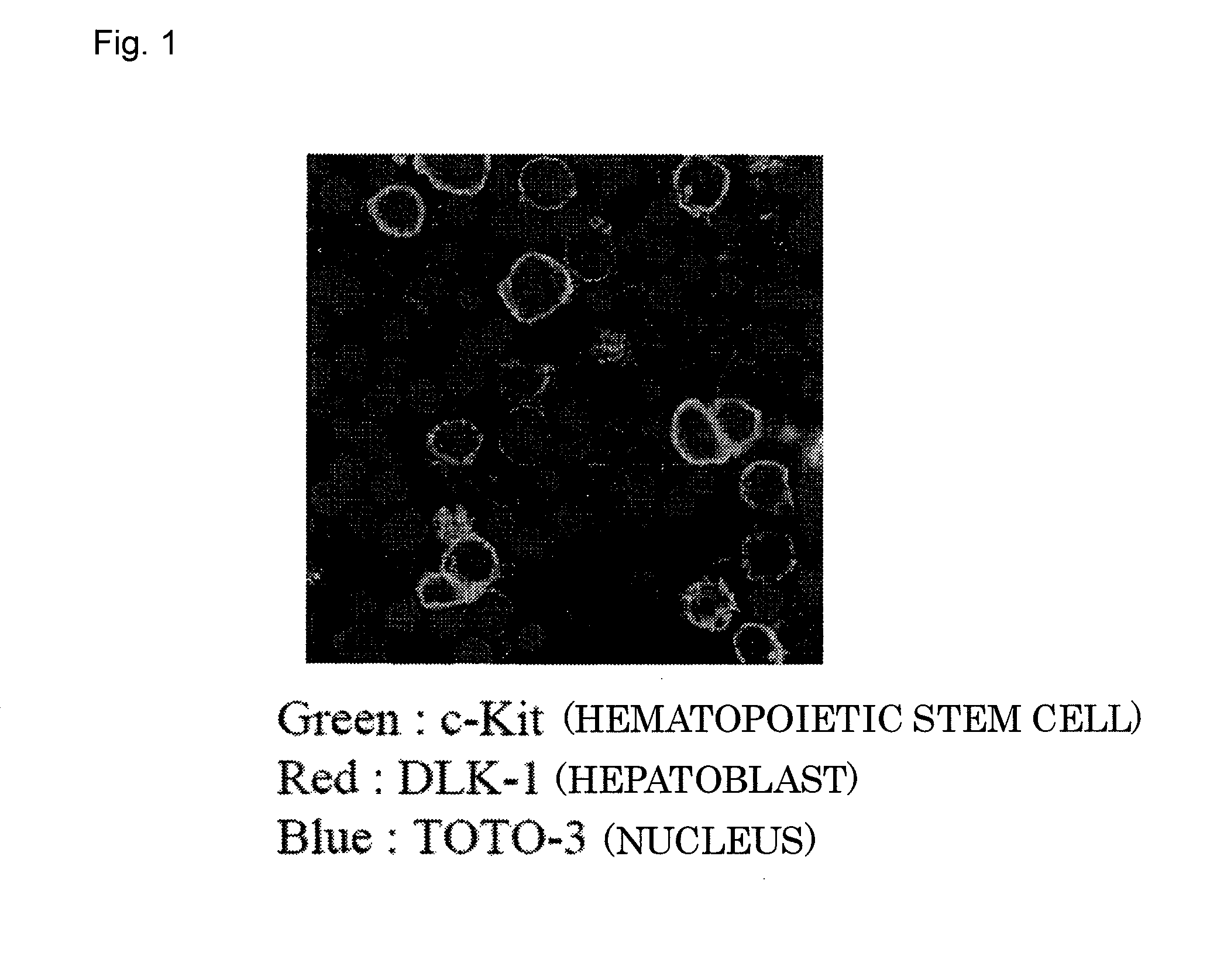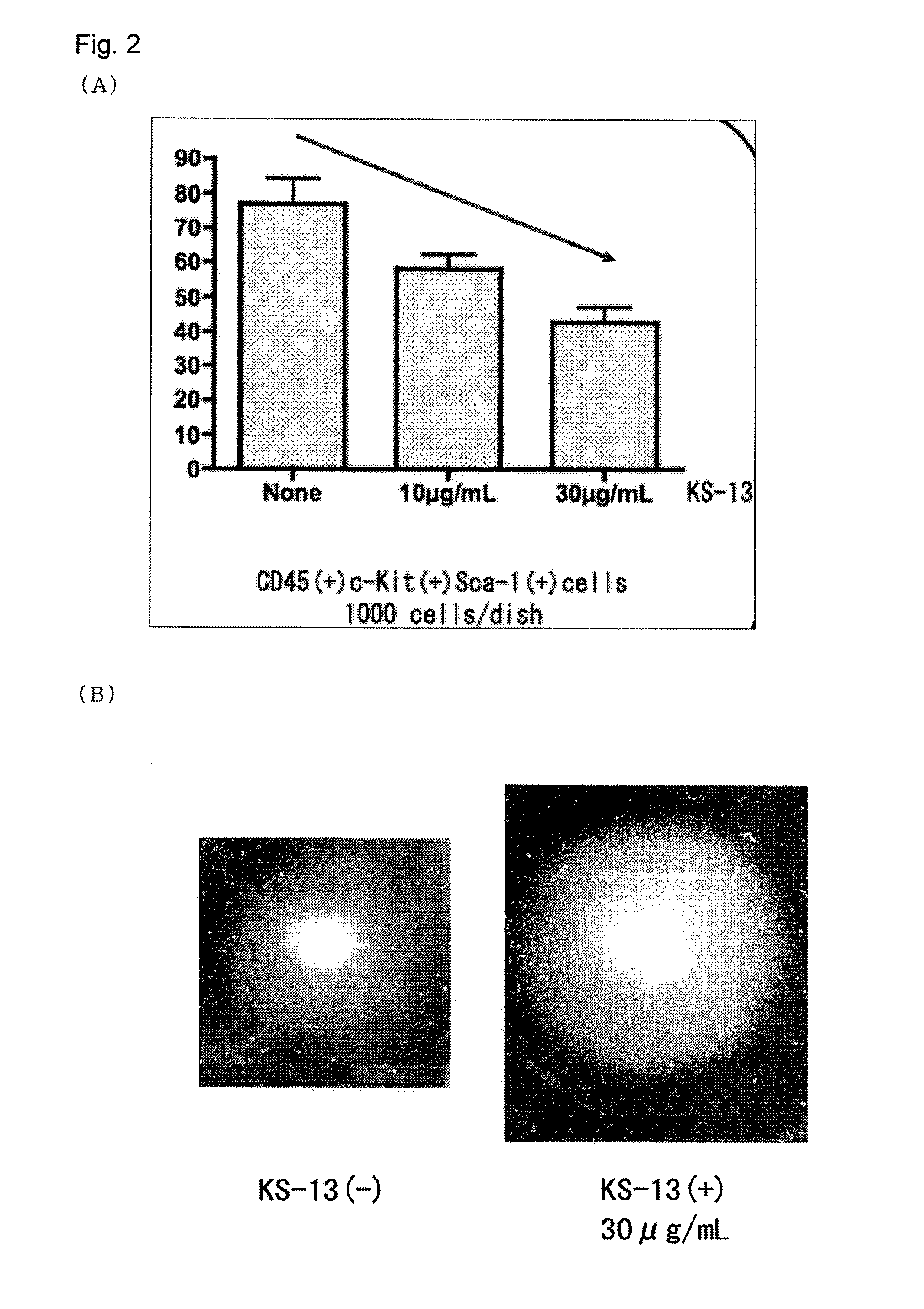Peptide inhibiting differentiation of hematopoietic stem cells or hematopoietic precursor cells and use of same
a technology peptides, applied in the field of new drugs, can solve the problems of affecting epigenetics, affecting the amplification efficiency difficult to maintain the undifferentiated state of hematopoietic stem cells, so as to prevent the “differential growth” and inhibit the differentiation
- Summary
- Abstract
- Description
- Claims
- Application Information
AI Technical Summary
Benefits of technology
Problems solved by technology
Method used
Image
Examples
example 1
Preparation of Peptide
[0165]As shown in FIG. 1, because hematopoietic stem cells (stained in green in the figure) are located near hepatoblasts (stained in red in the figure) in the liver in the embryo, hepatoblasts are considered to play an important role in the amplification of hematopoietic stem cells. Accordingly, in order to purify and collect hepatoblasts, an attempt was made to prepare antibodies that can be used in flow cytometry. From among multiple proteins expressed on the cell membrane of hepatoblasts, 10 types of peptides corresponding to the ectodomain and having high homology with both mouse and human were designed (hereinafter referred to as peptides A-J), and anti-peptide antibodies were prepared.
[0166]
A: cqkkdgpcvings(SEQ ID NO: 1)Cys Gln Lys Lys Asp Gly Pro Cys Val Ile AsnGly SerB: yecscapgysgkd(SEQ ID NO: 13)Tyr Glu Cys Ser Cys Ala Pro Gly Tyr Ser GlyLys AspC: pcqhggtcvddeg(SEQ ID NO: 14)Pro Cys Gly His Gly Gly Thr Cys Val Asp AspGlu GlyD: canngtcvsldgl(SEQ ID NO...
example 2
Preparation of Anti-KS-13 Antibody
(1) Immunization of Rats and Measurement of Antibody Titer
[0169]In order to prepare an antibody against KS-13 (anti-KS-13 antibody), rats were immunized four times at 2-week intervals in accordance with the routine method, using a peptide consisting of 12 amino acid residues (Cys at the N-terminal of KS-13 was deleted) as a peptide easily recognizable as an antigen and using KLH (keyhole limpet hemocyanin) as a carrier protein. Subsequently, the antibody titer was measured by ELISA using HRP-labeled anti-rat IgG. As a result, a sufficient increase in the antibody titer was observed.
[0170](2) Individual Screening
[0171]Using 3 rats (No. 1, No. 2, and No. 3), serum was collected before immunization and after immunization using the above-described peptide and carrier protein. Hereinafter, the experiment in which the serum before immunization was used is referred to as a control.
[0172]A hematopoietic stem cell population (Sca-1 (+)c-Kit(+)CD45(+) cells) ...
experimental example 1
Hematopoietic Colony-Forming Cell Assay
[0177]KS-13 (10 μg / mL or 30 μg / mL) was added to a semisolid medium (Methocult M3434 produced by STEMCELL Technologies) containing cell stimulatory factors (50 ng / mL of rm SCF, 10 ng / mL of rm IL-3, 10 ng / mL of rh IL-6, and 3 U / mL of rh EPO) (rm: recombinant form; rh: recombinant human form), and mouse fetal liver hematopoietic stem cells (CD45(+)c-Kit(+)Sca-1 (+)) (1,000 cells / dish) were cultured. Hematopoietic colony-forming cell assay was performed to evaluate the hematopoietic potential of the cells. Further, for comparison, hematopoietic colony-forming cell assay was performed in a similar manner using a KS-13-free liquid medium (none), and the hematopoietic potential of the cells was evaluated.
[0178]FIG. 2(A) shows the results of measurement of the number of colonies formed after culturing for 12 days. FIG. 2(B) shows the results of observation of the morphology of mixed colonies (in the absence of KS-13 and in the presence of KS-13 (30 μg / ...
PUM
| Property | Measurement | Unit |
|---|---|---|
| concentration | aaaaa | aaaaa |
| concentration | aaaaa | aaaaa |
| concentration | aaaaa | aaaaa |
Abstract
Description
Claims
Application Information
 Login to View More
Login to View More - R&D
- Intellectual Property
- Life Sciences
- Materials
- Tech Scout
- Unparalleled Data Quality
- Higher Quality Content
- 60% Fewer Hallucinations
Browse by: Latest US Patents, China's latest patents, Technical Efficacy Thesaurus, Application Domain, Technology Topic, Popular Technical Reports.
© 2025 PatSnap. All rights reserved.Legal|Privacy policy|Modern Slavery Act Transparency Statement|Sitemap|About US| Contact US: help@patsnap.com



